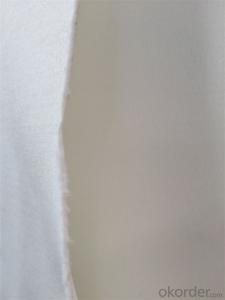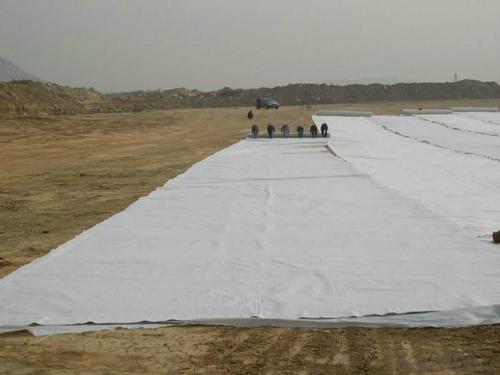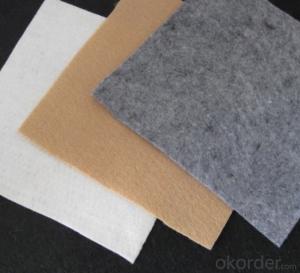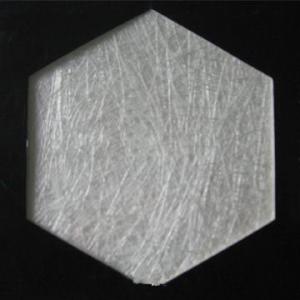Geotextil Leroy Short Fiber Needle Punched Non Woven Geotextile 1500g
- Loading Port:
- Qingdao
- Payment Terms:
- TT OR LC
- Min Order Qty:
- 5000 m²
- Supply Capability:
- 100000 m²/month
OKorder Service Pledge
OKorder Financial Service
You Might Also Like
Product Introduction
Geotextile has excellent permeability, acquired, durability, which can be widely used in railway ,highway, movement hall,Dams,hydraulic structures hence hole, coastal shoal, reclamation,environmental protection and other projects. The main products are Synthetic staple fibers needle punched nonwoven geotextiles and split film yarn woven geotextiles.

Product Specification
1. Weight: 100g~1500g
2. Width: 1m ~ 7m

Product Package:
Packing: Plastic film inside & Woven bag outside.
Shipping: About 15 days after receipt the deposit
 Product Application
Product Application
Filtration
Separation
Adding
Protection



FAQ:
Q: What kind of payments does jenor support?
A: T/T, L/C, Cash are accepted.
Q: Do you charge for the samples?
A: Accordeing to our company policy, the samples are freee, we only charge the freight fee. And we will return the freight fee during the next order.
Q: Can you produce according to customers' design?
A: Sure, we are professional manufacturer, OEM and ODM are both welcome.
Q: Do you have other products?
A: Yes, please check the pictures:
- Q: How do geotextiles help with erosion control in river channels?
- Geotextiles help with erosion control in river channels by providing a physical barrier that stabilizes the soil and prevents it from being washed away by flowing water. They also promote vegetation growth by allowing water to permeate while filtering out sediment, ultimately protecting the riverbanks from erosion.
- Q: What are the benefits of using geotextiles in construction projects?
- Geotextiles offer several benefits in construction projects. Firstly, they provide effective erosion control by stabilizing soil and preventing sediment movement, helping to maintain the integrity of embankments and slopes. Additionally, geotextiles act as a barrier against weed growth, minimizing maintenance efforts. They also enhance drainage and filtration systems, improving the overall performance of infrastructure projects. Furthermore, geotextiles can be used as reinforcement materials, providing strength and stability to various construction components like roads, retaining walls, and foundations. Overall, the use of geotextiles in construction projects offers cost-effective and environmentally friendly solutions for a range of engineering challenges.
- Q: Can geotextiles be used in geocomposite drains?
- Yes, geotextiles can be used in geocomposite drains. Geocomposite drains are comprised of multiple layers, including a geotextile layer that helps with filtration and separation. The geotextile layer allows water to flow through while preventing the passage of soil particles, making it an effective component in geocomposite drain systems.
- Q: Geotextile with the welding tool where to buy
- Local Hardware & Electrical City, about 5000 or so
- Q: How do geotextiles contribute to the longevity of geosynthetic clay liners?
- Geotextiles contribute to the longevity of geosynthetic clay liners by providing additional protection and reinforcement. They act as a barrier against punctures and abrasions, reducing the likelihood of damage to the clay liner. Geotextiles also help with filtration and drainage, preventing the buildup of water pressure and ensuring proper functioning of the clay liner. Overall, geotextiles enhance the performance and durability of geosynthetic clay liners, extending their lifespan and effectiveness.
- Q: Can geotextiles be used in green roof systems?
- Yes, geotextiles can be used in green roof systems. They can serve multiple purposes such as providing drainage, filtration, and separation layers. Geotextiles help to control water flow, prevent soil erosion, and promote healthy plant growth in green roofs.
- Q: Cement concrete bridge is a film curing or geotextile maintenance
- Commodity concrete pouring is completed, should be in the slurry after grinding as soon as possible to cover and sprinkler conservation. Commodity concrete bridge deck with full coverage of sprinkler conservation methods, covering materials with two sticky one geotextile, every 1t sprinkler once, to ensure the quality of conservation, to prevent cracks.
- Q: Engineering geotextile non-woven fabrics where the cheapest can buy, where the wholesale market?
- Manufacturers need to add 8720 -
- Q: What are the limitations of using geotextiles in high-water flow conditions?
- One limitation of using geotextiles in high-water flow conditions is their susceptibility to clogging. As water flows through the geotextile, it can carry fine particles and debris that may accumulate and clog the material, reducing its effectiveness. Additionally, in extreme flow conditions, the geotextile may not provide sufficient resistance or protection against erosion, leading to potential failure. Therefore, careful consideration of flow rates and proper maintenance are crucial to mitigate these limitations and ensure optimal performance of geotextiles in high-water flow conditions.
- Q: Can geotextiles be used in the protection of groundwater sources?
- Yes, geotextiles can be used in the protection of groundwater sources. Geotextiles are permeable fabrics that can effectively filter out impurities and prevent soil erosion. By installing geotextiles in areas where groundwater sources are vulnerable to contamination or excessive sedimentation, they can act as a barrier, allowing water to pass through while trapping pollutants and preventing them from reaching the groundwater. This helps to maintain the quality and purity of groundwater sources, ensuring their long-term protection.
Send your message to us
Geotextil Leroy Short Fiber Needle Punched Non Woven Geotextile 1500g
- Loading Port:
- Qingdao
- Payment Terms:
- TT OR LC
- Min Order Qty:
- 5000 m²
- Supply Capability:
- 100000 m²/month
OKorder Service Pledge
OKorder Financial Service
Similar products
Hot products
Hot Searches
Related keywords
































